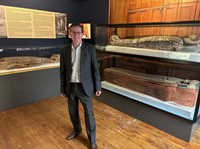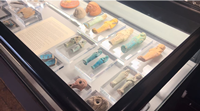Walk like an Egyptian in new museum space
ANCIENT Egyptian artefacts are giving a new lease of life to a forgotten Inverclyde museum space.
A former committee room within the Watt Institution which had been hidden away for almost 30 years has been resurrected and transformed into an Egypt Gallery.
The area had been used for storage for the past three decades but is now dedicated to telling the story of the ‘Land of the Pharaohs’ and features some artefacts from the museum’s renowned and vast Egyptology collection.
On display are wooden coffins, temple fragments, jewellery, and other artefacts dating back thousands of years.
The Watt Institution, which incorporates the McLean Museum and Art Gallery, Watt Library and Watt Hall, has a vast Egypt collection with approximately 300 items covering four-and-a-half thousand years of Egyptian history.

Some of the artefacts have been taken from the main museum space and relocated to the new gallery just off the Watt Hall which has freed up space to display more items from the rich archives.
The items are accompanied by new interpretation boards and a short film explaining the history of ancient Egypt and of the collection and its links to Greenock.
There is also low-level lighting to help create a mysterious atmosphere and aid the preservation of the precious artefacts.
The new Egypt Gallery has been been done as part of the National Lottery Heritage Fund Watt Voices Project.
Councillor Jim Clocherty, Inverclyde Council’s convener of education and communities, said: “The team here at the Watt Institution have done a fantastic job in bringing the popular Egypt collection to life for younger generations in Inverclyde and also for their parents who remember visiting the museum themselves and seeing the many fascinating artefacts when they were growing up.

“What this also does is delve more into how this collection came to Greenock in the first place and the strong links between the town and the early days of the exploration of Egypt.
“There’s an added benefit of giving a beautiful, old committee room a new purpose and freeing up space in the main museum area to showcase more of the incredible and vast archives for the people of Inverclyde and beyond to enjoy.”
The Egypt collection was donated to the museum in the late nineteenth and early twentieth century, a time of great public fascination with the ‘Land of the Pharaohs’.
The museum was one of many organisations and individuals who helped fund archaeological digs in Egypt.
This was done through the Egypt Exploration Fund, now known as the Egypt Exploration Society, an organisation established in 1882 by novelist, travel writer and Egypt enthusiast Amelia B. Edwards (1831-1893) and archaeologist Reginald Stuart Poole (1832-1895).
Its aim was to increase public knowledge and understanding of the history of Egypt.

Edwards also visited Greenock in 1888 to give a lecture on ‘The Buried Cities of Ancient Egypt’ for the Greenock Philosophical Society in the Watt Hall where the new Egypt Gallery is now located.
From 1888 to 1914 the museum supported the fund with local fundraising led by Egypt enthusiast and museum trustee, Thomas Law Patterson (1842-1915).
The wealth created in the town from its role in global industry and trade meant that many people had the money to support such initiatives.
More information about the Watt Institution is available on the Inverclyde Council website and also on the Watt Institution social media pages via the links in the Related Links and Other Websites sections of this page.